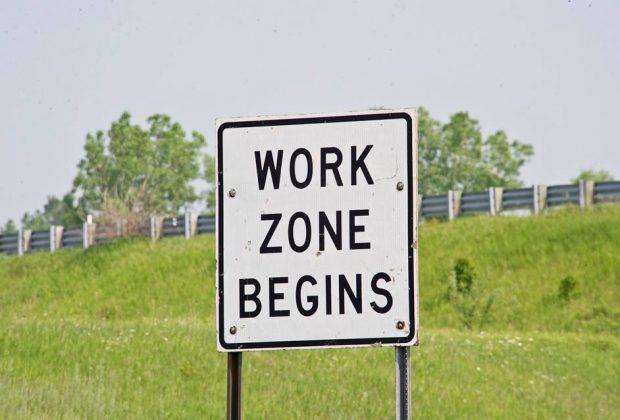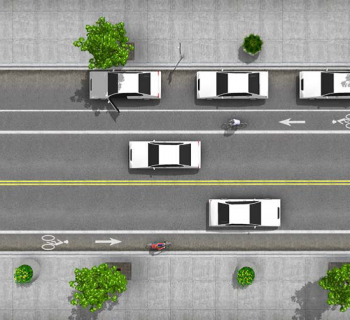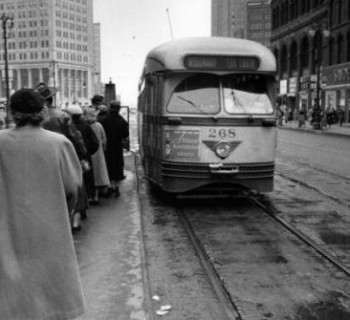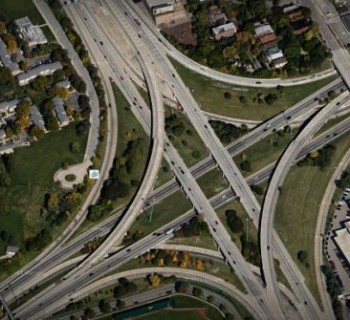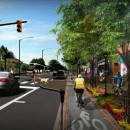Oakland County Executive L. Brooks Patterson took pains to stress the importance of transit during his annual State of the County speech earlier this year. Well, transit of a vehicular nature, anyways.
The Republican leader made the effort to expand I-75 — a plan that had been announced earlier in the day by state officials — a centerpiece of his Feb. 10 address.
"Let’s face it, I-75 is Oakland County’s Main Street," he said. "I-75, the busiest expressway in Michigan, becomes a parking lot at rush hour. We need relief and we’re going to get it.” An estimated 120,000 vehicles travel the heavily traveled freeway daily.
The widening, which is part of a much larger plan to repair and upgrade the expressway, would involve adding an extra lane north and south between M-59 in Auburn Hills and 8 Mile in Detroit.
Originally conceived in 2000, the plan received federal approval in 2006, but was put on hold for many years due to a lack of funding. Construction on the billion dollar endeavor is expected to begin this summer and last 14 years.
Patterson sees the project as a no-brainer.
"[It] will have a significant impact on commerce and driver convenience," he told an audience of 600 during his speech. "Companies along I-75, like Fiat Chrysler, that support I-75’s modernization, will see their employees in a safer commute; it will give companies along I-75 the ability to move goods more quickly through that corridor; and certainly improve the quality of life by easing some of the worst traffic congestion in our area."
But the county chief's endorsement of the plan is far from universal.
The I-75 widening has also generated pushback from several communities who don't feel adding more lanes to the expressway will benefit their residents: Mayor Mike Duggan of Detroit has tweeted his objections to it; Hazel Park, Oak Park and Southfield are reportedly against additional lanes; and Ferndale, Troy and Royal Oak have all recently adopted resolutions against the lane expansion.
The Ferndale resolution requests that the Southeast Michigan Council of Governments (SEMCOG) remove funding for the widening projects from its 2040 Long-Range Transportation plan — something its general assembly approved overwhelmingly in a 2013 vote.
Among other points, Ferndale’s resolution argues that population levels no longer justify adding lanes and that the widening will encourage sprawl.
Ferndale Mayor Pro Tem Melanie Piana, says her city supports repair and safety improvements on the expressway but has long opposed expanding its lanes.
"The reason we oppose it is because it's been proven that highway widening investment will not improve congestion in a meaningful way," Piana tells Mode Shift.
“We’re widening our highways and we have a problem in our region and state of maintaining what we have now,” adds Piana, “so increasing the amount of pavement on the roads when we can barely afford to maintain the roads is something that we’re concerned about.”
"After more than 60 years of experience, you'd think we'd have learned that widening highways is a road to ruin for our region," Joel Batterman of the Motor City Freedom Riders, a transit advocacy group, told Mode Shift. "And at a time when hundreds of thousands of people in our region, in the city and increasingly in the suburbs, lack access to an automobile, it's not just dumb, it's an unjust policy that further isolates the neediest people from jobs and cannibalizes older cities and suburbs."
Ferndale and other communities opposed to the widening had also supported SB 557, a bill sponsored by State Sen. Marty Knollenberg that would’ve ended the legal requirement that makes municipalities pay for a portion of the cost of opening, widening or improving state trunk lines like I-75. In regards to this, MDOT spokesman Robert Morosi tells Mode Shift it’s important to consider that the lane expansion is only a small aspect of the I-75 project.
"The first segment between South Boulevard and Coolidge Highway is being let [made available for bidding] and will improve safety on the freeway that has never been rebuilt since its original construction between 1957 and 1973,” he says. “Replacing worn out pavement and bridges, and bringing interchange movements up to modern day standards constitutes 90% of the project's cost."
Although the bill was passed by Michigan’s House and Senate, Gov. Rick Snyder on July 1, who cited concerns about fairness and a piecemeal approach to addressing road funding issues. The state legislature would need a two-thirds majority in each house to override his veto.
Regardless of the outcome of that struggle, tensions over the I-75 expansion are likely to persist. Barring an unexpected change of heart among communities represented in SEMCOG’s general assembly who voted for it in 2013, however, it’s becoming increasingly difficult to see any way that opponents might scuttle the widening project at this late date.


